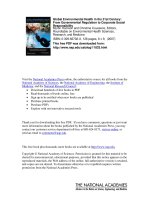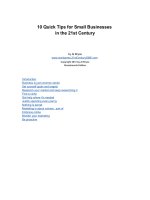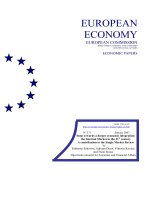West Virginia University-s Changing Mission in the 21st Century
Bạn đang xem bản rút gọn của tài liệu. Xem và tải ngay bản đầy đủ của tài liệu tại đây (1.7 MB, 366 trang )
Graduate Theses, Dissertations, and Problem Reports
2019
West Virginia University’s Changing Mission in the 21st Century
Katlin Swisher
Follow this and additional works at: />Part of the Higher Education Commons
Recommended Citation
Swisher, Katlin, "West Virginia University’s Changing Mission in the 21st Century" (2019). Graduate
Theses, Dissertations, and Problem Reports. 3919.
/>
This Dissertation is protected by copyright and/or related rights. It has been brought to you by the The Research
Repository @ WVU with permission from the rights-holder(s). You are free to use this Dissertation in any way that is
permitted by the copyright and related rights legislation that applies to your use. For other uses you must obtain
permission from the rights-holder(s) directly, unless additional rights are indicated by a Creative Commons license
in the record and/ or on the work itself. This Dissertation has been accepted for inclusion in WVU Graduate Theses,
Dissertations, and Problem Reports collection by an authorized administrator of The Research Repository @ WVU.
For more information, please contact
West Virginia University’s Changing Mission in the 21st Century
Katlin Swisher
Dissertation submitted to the College of Education and Human Services
at West Virginia University
in partial fulfillment of the requirements for the degree of
Doctor of Philosophy in Higher Education Administration
Erin McHenry-Sorber, Ph.D., Chair
Nathan Sorber, Ph.D.
Rodney Hughes, Ph.D.
L. Christopher Plein, Ph.D.
Department of Curriculum and Instruction/Literacy Studies
Morgantown, West Virginia
2019
Keywords: Higher education, higher education administration, mission, strategic planning,
leadership, organizational theory, land-grant universities, land-grant mission, university
presidents, West Virginia, saga
Copyright 2019 Katlin Swisher
ABSTRACT
West Virginia University’s Changing Mission in the 21st Century
Katlin Swisher
In the midst of the ongoing shifts of the perception of higher education and the public’s
question of the role and value of public universities, West Virginia University has
simultaneously experienced institutional change through five different presidential
administrations in a decade. As seen through WVU’s historical context as the state of West
Virginia’s land-grant, flagship, research university, the institution has and continues to face
many administrative, policy, and contextual changes as it strives to meet its strategic goals and
operationalize its mission. Through document analysis and interviews with key officials, this
qualitative, multi-case study seeks to understand how WVU’s mission as a land-grant university
and its resulting strategic plan have shifted in the 21st century from one presidential
administration to the next; how those changes have positioned the University within the
overarching land-grant saga; and how those changes have influenced the work of the
administrations as they operationalized the land-grant mission.
WVU’S LAND-GRANT MISSION
iii
TABLE OF CONTENTS
List of Tables………………………………………………………………………….………….iv
List of Figures…………………………………………………….……………………..………...v
Acknowledgments……………………………………………………………………….……….vi
Chapter 1: Introduction……………………………………………………………………………1
Chapter 2: Literature Review…………………………………………………………………….13
Chapter 3: Methodology………………………………………………………………...……….63
Introduction to the Findings……………………………………………………………..……….85
Chapter 4: David C. Hardesty’s Administration…………………………………………………92
Chapter 5: Michael Garrison Administration………………………………………………......156
Chapter 6: C. Peter Magrath’s Administration……………………………………….………...176
Chapter 7: James P. Clements’ Administration………………………………………………...198
Chapter 8: E. Gordon Gee’s Administration……………………………………………….…...259
Chapter 9: Conclusion…………………………………………………………………………..304
References………………………………………………………………...…………………….337
Appendix A: Participant Cover Letter………………………………………………………….356
Appendix B: Interview Protocol…….………………………………………………………….357
WVU’S LAND-GRANT MISSION
iv
LIST OF TABLES
Table 3.1: List of Participants………………………………………………..……………….….77
WVU’S LAND-GRANT MISSION
v
LIST OF FIGURES
Figure 4.1: Hardesty Timeline………………………..………………………………………….93
Figure 4.2: Hardesty Organizational Saga…………………………..……………………...……94
Figure 5.1: Garrison Timeline……………………………………………………………….….157
Figure 5.2: Garrison Organizational Saga…………………………..……………………...…..157
Figure 6.1: Magrath Timeline……………………………………….…………………..……...177
Figure 6.2: Magrath Organizational Saga…………………………..………………….……….177
Figure 7.1: Clements Timeline…………………………………………………………..……..199
Figure 7.2: Clements Organizational Saga…………………………..………………………....199
Figure 8.1: Gee Timeline……………………………………………………………...………..260
Figure 8.2: Gee Organizational Saga…………………………..……………………………….261
WVU’S LAND-GRANT MISSION
vi
Acknowledgments
I am deeply indebted to my best friend and husband, Kyle Swisher, for his constant
support and willingness to always brainstorm, listen, and talk through ideas with me.
My parents have provided invaluable support and encouragement over the course of my entire
education. Mumsy, thank you for your willingness to proofread every last paper and article I
send your way. Dad, thank you for teaching me that no goal is ever beyond my reach—"It’s not
where you start; it’s where you finish.” I am also grateful to my entire family for their support,
patience, and flexibility throughout the research and writing process.
This study would not have been possible without the support and guidance of Dr. Erin McHenrySorber, whose words of wisdom and critical questions helped shape, improve, and refine my
thinking and writing. I want to thank Dr. Nathan Sorber, whose passion for land-grant
universities and innovative course on the topic inspired this study. Dr. Rodney Hughes shared
ideas for many aspects of the research. Dr. Christopher Plein provided a wealth of knowledge
and insightful conversations throughout this study.
As a first-generation student, I am deeply grateful to the many educators with whom I crossed
paths over the years at Hurricane Town Elementary School, Hurricane Middle School, Hurricane
High School, and WVU’s Reed College of Media. You molded me into the student and scholar I
am today. To my undergraduate advisors: Dr. Diana Martinelli, thank you for encouraging me
every step of the way since my first day as a WVU student. You are a shining example of
leadership in higher education. Dr. Jan Boyles, thank you for pushing me to apply to become an
orientation leader as a freshman. You recognized what my future could look like before I even
knew what was possible. I also wish to thank my marching band directors, Mr. Sam Leffingwell,
Mr. John Hendricks, Mr. Jay Drury, and Mr. Christopher Nichter, for instilling in me discipline,
attention to detail, work ethic, and leadership skills that parallel none. I continue to use the
lessons I learned from you every day.
To Kate McKeen, Adele Siba, Kate Padula, and Ryan Boyd: Thank you for your mentorship and
for taking a chance on a young, aspiring administrator with big dreams. I would not be where I
am today without the opportunities you gave me early on in my career. To Ernie Goeres, who
first encouraged me to pursue a doctoral degree.
Finally, I would like to extend my sincere thanks to the leaders at West Virginia University who
were willing to take the time to share their stories and experiences with me.
WVU’S LAND-GRANT MISSION
Chapter 1: Introduction
1
WVU’S LAND-GRANT MISSION
2
Since the Great Recession in 2007-2008, universities have experienced decreasing state
appropriations coupled with rising costs of resources. This increasing privatization of American
public higher education institutions, particularly land-grant universities, reflects a transition from
the Golden Age of land-grant universities, which featured enrollment growth and expansion of
services and resources (Sorber & Geiger, 2015), to an era of neoliberalism and privatization
(Brackmann, 2015).
Decreasing state funding since the Great Recession continues to change the economic
context of higher education. Per-student appropriations to Association of Public and Land-Grant
(APLU) institution members decreased by 27%, or $2,718, from 2006-2007 to 2012-2013, and
institutions responded by increasing tuition and fee revenues on average by $2,400 per student
(Johnson & Yanagiura, 2015). This trend toward increased privatization has pushed land-grant
universities to reconceptualize their missions, and, ultimately, their legacies.
Land-grant universities have experienced competing and conflicting mandates of how
their missions should be carried out from their inception via the Morrill Act of 1862. While the
legislation broadly called them to be an alternative for practical education and instruction in
agriculture, science, mechanics, and technology, nearly every state approached the establishment
of the land-grant university differently based on political demands and socioeconomic contexts
in the regions they were located. Examples ranged from creating new universities and
agricultural and mechanical institutions to giving the land-grant to pre-existing institutions, both
agricultural and non-agricultural (Sorber & Geiger, 2015). These variances were also seen in the
development and delivery of the curriculum and other offerings, broadly categorized as practical
and vocational application verses scientific and liberal arts (Sorber & Geiger, 2015) and even
home economics (Thelin, 2011).
WVU’S LAND-GRANT MISSION
3
A commonality shared by the land-grant universities is the romantic narrative that
surrounds them, idealized by the notion that they were created to bring education to the people,
expanding access more than any other institution type. More recently, likely motivated by the
Morrill Act’s 2012 sesquicentennial anniversary, land-grant universities have faced critiques of
this ideal, both in terms of access for women and African Americans (Sorber & Geiger, 2015;
Thelin, 2011) as well as their lack of engagement in and accountability to the communities they
serve (Brackmann, 2015; Gavazzi, 2015; Kellogg Commission on the Future of State and LandGrant Universities, 1999; Klein & Woodell, 2015; Fitzgerald, Bruns, Sonka, Furco, & Swanson,
2012; McDowell, 2001; McDowell, 2003; Reilly, 2003).
These critiques reflect a shift in the land-grant saga, particularly the ways in which landgrants are perceived across stakeholder groups—agriculture, industry, higher education,
government, and the communities they serve. As they face these challenges of declining state
appropriations, resulting budget cuts, and public accountability critiques, many institutions have
been forced to make a choice: maintain their operational status quo while monitoring the
changes; move away from their traditional missions of access, affordability, and practical
education in favor of increased tuition revenue and changing academic offerings; or reengage
with their missions through increased accountability to their communities and innovative,
economic development- and partnership-based approaches to research, teaching, and service.
Though these state-level funding cuts to higher education funding came several years
later in West Virginia than most other states, the current situation in the state is no different. As a
result, West Virginia University (WVU), the state’s 1862 land-grant institution, faces similar
challenges of declining state investment in higher education coupled with a declining collegegoing age population and ongoing questions of the public value of higher education.
WVU’S LAND-GRANT MISSION
4
West Virginia as a whole is facing an economic crisis that continues to impact public
higher education. Only 11% of the state’s base budget, or about $497 million, is appropriated for
higher education (O’Leary & Boettner, 2016). In fiscal year 2015, West Virginia cut higher
education more than any other state except Wyoming, decreasing per-student appropriations by
more than 20% since the 2008 recession (Mitchell, Palacios, & Leachman, 2014). Consequently,
the state’s public higher education institutions decreased their budgets by three percent, or $9.6
million overall, equating to about $330 per student (Mays, 2014). This response ultimately
translated to personnel and program cuts for the higher education institutions coupled with
tuition increases to decrease costs to ultimately generate revenue. To mitigate the expected $500
million budget deficit for fiscal year 2017, state budget proposals included up to $600 million in
overall budget cuts (McElhinny, 2017), including up to 15% of WVU’s base budget. Yet, at $2.2
billion (Bowen & Meszaros, 2016), WVU is the only higher education institution in America to
be its state’s top economic generator.
In the midst of these ongoing shifts of the perception of higher education and the state
legislature’s question of the role and value of public universities, as seen through the previous
discussion of decreased appropriations, WVU has also experienced institutional change through
five different presidential administrations in a decade. As a result of these administrative, policy,
and contextual changes, this study seeks to understand how WVU’s mission as a land-grant
university and its resulting strategic plan have shifted in the 21st century from one presidential
administration to the next; how those changes have positioned the University within the
overarching land-grant saga; and how those changes have influenced the work of the
administrations as they operationalized the land-grant mission.
WVU Historical Context
WVU’S LAND-GRANT MISSION
5
West Virginia University’s history as a higher education institution has been captured
comprehensively via two books: William Doherty and Festus Summers’s (1982) West Virginia
University: A Symbol of Unity in a Sectionalized State and Ron Lewis’s (2013) Aspiring to
Greatness: West Virginia University Since World War II. Additionally, David Hardesty’s (2007)
memoir of his presidential tenure situates his administration’s role in the broader historical
context through his perspective.
A prominent theme across these histories is the strategies by which WVU sought to fulfill
its goal of becoming a Carnegie Foundation Highest Research Activity institution (i.e. Research
1 or R1). While WVU achieved that classification in 2015 a premise in these histories, especially
Lewis’s (2013), is the process of reaching that goal and challenges the University faced in
reaching it. Three overarching obstacles to goal attainment include: lack of sufficient financial
resources due to the state’s perpetually weak economy and declining financial commitment to
the institution; persistent and corrosive intra-state regionalism and geographic divide,
particularly in public attitudes, state and local politics and the media due to the small state’s
mountainous terrain and poor infrastructure; and continual shifts in higher education governance
systems and state processes. While these challenges were identified early in WVU’s history, they
are themes that continue to influence WVU’s mission and strategic plan today as described in the
next chapter’s literature review.
Research Questions
As the state’s land-grant, flagship, research university with a comprehensive medical
center, WVU has and continues to face many administrative, policy, and contextual changes as it
strives to meet its strategic, missional, and policy-related goals. The following research questions
seek to explore WVU’s mission as a land-grant university, its resulting mission and strategic
WVU’S LAND-GRANT MISSION
6
planning shifts in the 21st century from one presidential administration to the next, and the ways
in which those changes have positioned the University within the land-grant saga.
1. How has West Virginia University’s mission and strategic plan changed across the
presidential administrations of David Hardesty (1995-2007), Mike Garrison (2007-2008),
C. Peter Magrath (2008-2009), James Clements (2009-2013), and E. Gordon Gee (2013present)?
2. How did those shifts in mission and strategic plan influence WVU’s positionality within
the land-grant saga?
3. 3. How did this shifting positionality influence the work of the institution across these
periods?
Theoretical Framework
Higher education organizational saga (Clark, 1971; Clark, 1972) will serve as the
theoretical framework for this study. While most higher education theory focuses on college
students and their development, learning, and experiences (e.g. Pascarella & Terenzini, 2005),
this theoretical framework is specific to higher education as an institution and as an organization.
It is also based in qualitative inquiry, specifically the constructionist epistemology. Therefore, it
is the most appropriate theory for these research questions as they relate to leadership,
institutional structure, governance, mission, and strategic planning.
There are several ways to understand higher education as an enterprise through Clark’s
organizational saga because the framework offers multiple stages and settings in which the saga
can develop, both in the short-term and over time. The framework also offers the opportunity to
make meaning from the context of what occurs in the organization. In addition, it reflects how
“different groups of actors, policymakers, academics, managers, and administrators interact and
shape the field of higher education” (Fumasoli & Stensaker, 2013).
As an organization or enterprise, higher education has many specific features that
characterize it: maturity; slowness (or in some cases, unwillingness) to change; loosely-coupled
WVU’S LAND-GRANT MISSION
7
system(s); concrete, bureaucratic structures and processes; complacency about the security of its
market niche (i.e. teaching, research, and learning); the need to work actively to remain dynamic
as a result of this potential for complacency; a mix of interdependence and independence among
individuals, programs, and other entities that comprise the organization; unique practices (e.g.
granting tenure to faculty); and the public versus private good debate (Manning, 2013; Gayle,
Tewarie, & White, Jr., 2003). While organizational saga assumes the higher education institution
is rational, meaning there are reasonable explanations for why decisions are made or why actions
are taken, it also reflects the emotional connections for stakeholders involved in the organization,
which demonstrates how a “formal place can become a beloved institution” (Clark, 1972, p.
178).
Clark defines organizational saga as “a collective understanding of unique
accomplishment in a formally established group” (Clark, 1972, p. 178). That understanding is a
narrative that not only represents the history of the organization but also represents the beliefs of
a core group of individuals. “The element of belief is crucial, for without a credible story, the
events and persons become history; with the development of belief, a particular bit of history
becomes a definition full of pride and identity for the group” (Clark, 1972, p. 178). As a result of
this reliance on normative bonds, or the beliefs and loyalties of the individuals in the
organization, organizational saga moves beyond just structural composition of the organization
to focus on the cultural, emotional, and expressive aspects, demonstrating how organizations can
be humanized by the individuals who are a part of them. “With a general emphasis on normative
bonds, organizational saga refers to a unified set of publicly expressed beliefs about the formal
group that (a) is rooted in history, (b) claims unique accomplishment, and (c) is held with
sentiment by the group,” (Clark, 1972, p. 179).
WVU’S LAND-GRANT MISSION
8
Organizational saga develops in two stages: initiation (short-term) and fulfillment (longterm). Initiation is characterized by strong purpose, a short time-frame, and execution by a single
leader or small group (Clark, 1971, 1972). Initiation can occur in a variety of settings: a new
organization or an organization under new leadership; an organization in crisis, such as one
dealing with a major controversy or scandal; and an organization that is established but ready
and poised for evolutionary change (Clark, 1971, 1972). After a saga develops, it takes time for it
be fulfilled, and it does so in a more predictable manner than the initiation stage. For the saga to
achieve fulfillment, it must reach five populations or places within the higher education
institution: personnel, program, social base, student subculture, and imagery (Clark, 1971, 1972).
Personnel primarily encompasses a set of key believers—faculty. While the saga can be
initiated by a single leader (e.g. the president) or small group, fulfillment requires commitment
from the faculty. Their buy-in results in their taking responsibility for carrying out the saga over
time and protecting it against possible threats, such as new leadership (Clark, 1972).
Program is comprised of the visible practices of the saga’s implementation that reflect the
mission, vision, and values of the institution through the saga. Examples include curriculum
offerings, approaches to instruction, research accomplishments, and service opportunities, the
practices that demonstrate the organization’s distinctiveness (Clark, 1972).
Social base refers to another key population—alumni. These are “believers devoted to the
organization” who “hold beliefs enduringly pure” because they are rooted in the past and have
not been jaded with the challenges facing the current administration (Clark, 1972, p. 182).
Student subculture represents a key population currently connected to the organization—
the students themselves. Like faculty, when students buy in to the saga, they also hold
WVU’S LAND-GRANT MISSION
9
themselves responsible for maintaining and contributing to it while also taking pride in it (Clark,
1971, 1972).
Imagery is the final place the saga must reach to be fulfilled. Imagery is how the saga is
most widely expressed, not only across faculty, staff, students, and alumni, but in the traditions
of the institution itself, e.g. through its brand, statues, ceremonies, events, signage, and other
cultural representations (Clark, 1972). “As the account develops, believers come to sense its
many constituent symbols as inextricably bound together, and the part takes its meaning from the
whole” (Clark, 1972, p. 183).
The durability of sagas varies based on the organization type. Robust sagas struggle to
develop strongly in passive organizations (Clark, 1971). Instead, they are more likely to develop
and have a lasting impact in highly structured contexts, which is why higher education is an
optimal venue for organizational saga (Clark, 1971).
Once fulfilled, the organizational saga gives the institution unity and helps overcome
silos and boundaries while bringing connection to the intricate complexities of the structure.
“When the saga is firmly developed, it is embodied in many components of the organization,
affecting the definition and performance of the organization and finding protection in the
webbing of the institutional parts,” (Clark, 1972, p. 179).
The examination and interpretation of Clark’s higher education organizational saga will
help explicate the nature and significance of this study on how WVU’s mission and strategic
plan have changed across five presidential administrations in a decade, how those shifts have
influenced WVU’s positionality within the land-grant saga, and how those shifts have affected
the work of the institution across this time period. The study will use the stages of Clark’s
organizational saga to identify how and when changes were initiated and how those changes
WVU’S LAND-GRANT MISSION
10
were operationalized in the five subsequent stages of personnel, program, social base, student
subculture, and imagery.
As we trace the effects of an organizational saga on belief and trust and then on the
problems of governance, we turn our attention away from structure changes . . . and focus
instead on the size and scope and mission of the entity that is to be governed. We return to
the embodiment of goals in the historical development of an organization and what
meaning is thus available to those who give so much of their lives there. (Clark, 1971, p.
515)
Significance of the Study
As discussed above, West Virginia University has two formally documented histories,
Doherty and Summers (1982) and Lewis (2013). At the time of this writing, at least six years
will have passed from the most recent published historical account. While this may seem like a
short timeframe given the institution’s long history, since these publications, West Virginia has
experienced shifting political and economic contexts, which, in turn, have influenced changes in
higher education, especially WVU.
WVU has been led by five presidents in 10 years. It departed the Big East Conference
and joined the “power five”-member Big 12 Conference in 2012, bringing with it increased
revenue from the new conference membership, athletic fundraising, and beer sales at athletic
events (Jessop, 2013). It earned the Carnegie Classification of Institutions of Higher Education’s
distinct R1 highest activity research designation in 2015 (West Virginia University, 2017). It set
record enrollments in terms of first-time freshman students, academic profile, Honors College,
and diversity (Bolt, 2017; Dobies, 2014). It moved a divisional campus to a new location
WVU’S LAND-GRANT MISSION
11
(Loftstead, 2015), celebrated its sesquicentennial, and concluded a 10-year, $1.2 billion capital
campaign in 2017 (Nevin, 2018).
Simultaneously, WVU has been influenced by state-level economic and political
contexts, facing a series of cuts to state appropriations to public higher education (Mitchell,
Palacios, & Leachman, 2014; Mays, 2014; McElhinny, 2017) coupled with more responsibility,
flexibility, and autonomy through bills like West Virginia House Bill 2542, which permits more
flexible hiring and firing practices (West Virginia University Bureaucracy Busters, 2017). As a
land-grant university, it is also navigating the movement to define its mission as an engaged
institution in the midst of calls for accountability, community partnership, and economic
development (Brackmann, 2015; Gavazzi, 2015; Kellogg Commission on the Future of State and
Land-Grant Universities, 1999; Klein & Woodell, 2015; Fitzgerald et al., 2012; McDowell,
2001, 2003; Reilly, 2003).
This rapid transformation in such a brief time period presents multiple layers of
significance for the study. It is an opportunity to fill the gap in WVU’s history; to document and
explore WVU’s current situation within the land-grant saga and relationship with the state of
West Virginia; and to highlight how and why these changes have come about through the
documents that represent them and the individuals who were catalysts for making them happen.
Beyond documenting the historical and institutional knowledge, this study seeks to
exemplify the land-grant saga through the narrative of a specific university and its changes in
leadership, mission, and strategic planning. While there is a significant body of literature on the
history of land-grant universities and how the land-grant movement has progressed over time,
fewer studies have been published about the land-grant movement since the sesquicentennial of
the Morrill Act of 1862 in 2012, which offers an opportunity to conduct an emerging exploration
WVU’S LAND-GRANT MISSION
12
of the land-grant saga by examining the modern land-grant university in the face of changing
broader contexts for higher education and in more specific state-level contexts. Through the lens
of a specific institution, i.e. WVU, this study is an opportunity to define what it means to be an
engaged land-grant university, including identification of accountable publics, missional
expectations, and responsibilities.
With that said, these changes would not occur without the leadership initiating them. This
study is also an opportunity to highlight the presidential visions pursuing these changes.
Presidential aspirations are often just that—aspirations. The real test of an administration is to
manage the embedded culture of higher education as an industry and the challenges it faces, and
this study is an opportunity to consider those approaches through characteristics like the role of
the presidency, presidential retention, average tenure, political capital, and institutional
reputation. By considering how these changes were operationalized in the presidential
administrations, the study will also demonstrate how the leadership’s interpretation of the landgrant mission influenced the institution’s positionality in the land-grant saga and the work of the
institution across these time periods.
WVU’S LAND-GRANT MISSION
Chapter 2: Literature Review
13
WVU’S LAND-GRANT MISSION
14
The Land-Grant Saga
The land-grant saga is not easily defined despite the rich history magnifying the
institutions that were established by or evolved out of the Morrill Act of 1862 and other
subsequent legislation. Conflicting definitions and mandates of how the land-grant mission
should be interpreted and implemented outwardly have faced land-grant colleges and universities
from the very beginning of their inception.
Created by the Morrill Act of 1862, the legislation allocated land to each state to establish
a university for the people—a higher education institution that offered an alternative to the
private, elite universities, one that featured practical, useful education and instruction in
mechanics, sciences, and technology to use science to improve the workforce and industry, e.g.
agriculture and mechanical arts, leading to ground-breaking research that has been the catalyst in
transforming the United States into the global economic power it is today. However, because
many states were so settled and populated by this time, there was often not enough land to meet
the minimum allocation requirement. In these instances, states received scrip equivalent to the
value of land (based on the number of senators and representatives) to sell to establish landgrants, often as part of pre-existing institutions. The universities established as land-grants were
called to be “accessible to all, but especially the sons of toil;” provide “instruction in the
practical avocations of life” as well as “other scientific and classical studies;” and be “the
guidance of the industry of this country” (Morrill Act of 1862, 2018) with motives ranging from
democratizing education and developing a utilitarian curriculum featuring instruction, research,
and public service to emphasizing developing industries in the applied sciences, especially
agriculture and engineering (Williams, 1991). Even with these guiding tenants, nearly every state
approached their institutional and organizational development differently based on political
WVU’S LAND-GRANT MISSION
15
demands and socioeconomic contexts in the regions they were located. Some states created new
universities or new agricultural and mechanical colleges, while others opted to award the landgrant to previously established institutions (Sorber & Geiger, 2015). The curriculum and the
delivery of that curriculum saw just as much variance, ranging from practical applications and
vocational courses to the arts and sciences (Sorber & Geiger, 2015; Thelin, 2011). For example,
“the classical curriculum of antebellum colleges [was] consistently portrayed as the villain in the
land-grant saga, by contemporary proponents of practical education and by present-minded
historians” (Geiger, 1998, p. 8).
As a result, the original land-grants under the Morrill Act of 1862 offer an eclectic
approach to higher education, sharing few defining characteristics beyond their connection to the
original Morrill Act. George Williams (1991) describes the movement as a “collective story”
about institutions with an “exclusive relationship with the federal government” and a few shared
obligations encased by the “expression and diffusion of certain political, social, economic, and
educational ideals” (p. 1). Broadly, a characteristic that has united these institutions over the
years is the romanticized view of the land-grants as colleges providing education “for the
people” and celebrations of democracy and access (Williams, 1991). The reality, though, is that
most students who enrolled came from the middle class or were even children of wealthy farmers
aspiring to exit their agrarian upbringing in favor of a new life in an emerging white-collar career
path. Further, the “for the people” definition was not reached until much later, as widespread
offerings were not available for African Americans until the Morrill Act of 1890 or women until
the 20th century (Sorber & Geiger, 2015; Thelin, 2011; Williams, 1991).
While still commonly personified, the romantic vision may be, in part, a thing of the past.
The sesquicentennial of the Morrill Act presented an opportunity for critique of that ideal as the
WVU’S LAND-GRANT MISSION
16
realities set in of the challenges land-grant universities faced, not unlike other public, research
universities: declining state support for higher education and subsequent budget cuts and
consideration of alternative revenue sources, including student tuition (Brackmann, 2015). For
example, in response to growing public frustration regarding perceived unresponsiveness of
public and land-grant universities, the Kellogg Commission on the Future of State and LandGrant Universities (1999) published a report. The report called on land-grant institutions to
return to their roots and engage more with the communities where they are located to become
more aware of local problems and use their expertise in a more targeted, intentional way.
Authored by 26 land-grant presidents and chancellors and framed as a dear colleague letter, the
report gave land-grant leaders a test to measure their responsiveness to and engagement with the
community. The test included seven components: responsiveness to community needs, respect
for community partners, academic neutrality, accessibility, integration, coordination, and sharing
of scarce resources (Kellogg Commission on the Future of State and Land-Grant Universities,
1999).
Beyond giving the institutions an unprecedented expectation of how to fulfill their
missions moving forward, this literature also served as the foundation for other missional and
accountability critiques of land-grant universities as well as recommendations for engagement.
The Association of Public and Land-Grant Universities’ “The Centrality of Engagement in
Higher Education” report is just one example (Fitzgerald et al., 2012). In this white paper by the
APLU’s Council on Engagement and Outreach, the authors provide a historical look at how
land-grant universities have engaged with their communities over time, including through the
original Morrill Act; the Hatch Act, which established research centers for sharing agricultural
and nutritional knowledge in communities; and the Smith-Lever Act, which created the
WVU’S LAND-GRANT MISSION
17
extension services. Together, these three policies established mandated educational opportunities
in communities where, for the most part, they previously didn’t exist. Fitzgerald et al. (2012)
also created a new definition of engagement based off the Kellogg Commission’s report (1999)
as well as those from other national higher education organizations, including the Association of
American Colleges and Universities, the American Association of Community Colleges, the
Council of Independent Colleges, Campus Compact, and Imagining America. It states that
engaged scholarship should be scholarly; should cut across institutions’ research, teaching, and
service missions; should be reciprocal and mutually beneficial for the higher education
institutions and their communities; and should reflect a civil democracy (Fitzgerald et al., 2012).
Beyond defining engagement, the report also makes recommendations for higher education
leaders as to how they can change the culture of their institutions to reflect engagement and
makes the case for why engagement makes sense in the current public outlook of higher
education.
Similarly, Gavazzi (2015) calls for universities to shift their culture to one of community
engagement through town-gown relationships, where they make direct contributions to human
capital in the communities where they are located. Following a mixed methods study to analyze
institutions town-gown relationships, he found that both communities and universities seek a
harmonious relationship, which requires high effort and high comfort. Gavazzi (2015) goes on to
suggest that institutions need to do more than just share their physical space (e.g. campus
buildings and other resources); instead, he recommends that university leadership should meet
regularly with community members to identify what their needs are and how the university can
support those needs. While this recommendation is primarily to serve the communities, Gavazzi
(2015) also indicates that this approach could also be what “saves” higher education with regard
WVU’S LAND-GRANT MISSION
18
to questions of value, perception, and funding—a culture shift toward innovation and
engagement could be the solution to many challenges currently facing higher education.
Gavazzi also collaborated with WVU President E. Gordon Gee (2018) to explore the
future of higher education and the land-grant’s role in that. They call for land-grant universities
to reengage with their missions to better serve the public good and respond to the challenges
facing higher education by becoming “more fiercely land-grant in [their] orientation” (p. 1)
rather than the more homogenized higher education marketplace. To achieve this differentiation,
they recommend a servant leadership mentality for all land-grant presidents, allowing them to be
“more mindful of their original purpose and attentive to their intended audience” (p. 5) because
of the “bilateral bond” land-grant universities have with their communities. “Critical decisions
made at all levels of leadership should be filtered first through the lens of what provides
maximum benefit for the citizens of each state and for American society at large” (Gavazzi &
Gee, 2018, p. 34).
Like Gavazzi and Gee (2018), Robert Sternberg, former provost at Oklahoma State
University, believes servant leadership is what will help differentiate land-grant universities from
other institution types. In his 2012 edited book on the modern land-grant university, Sternberg
acknowledges that “land-grant institutions will be challenged to be true to their missions” (p. xi),
especially as state appropriations and support continues to decline, and that servant leadership is
an opportunity to reengage with their missions. “If land-grant institutions forget this mission of
service, they will lose the essence that makes them special and unique valuable as institutions of
higher learning” (Sternberg, 2012, p. xi).
Michael Crow and William Dabars, president and senior research fellow, respectively, at
Arizona State University, the nation’s largest public research university, also endorse this idea of









